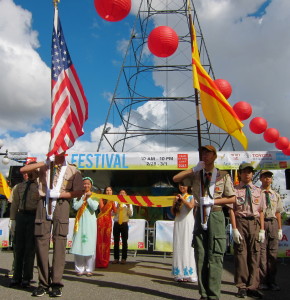
By Sharon Simonson
Asians and Pacific Islanders now form the largest racial block in Santa Clara County, exceeding the proportion of non-Hispanic white residents for the first time.
According to new demographic findings from the Population Dynamics Research Group at the University of Southern California, in the next 25 years, Silicon Valley’s Indian, Chinese, Vietnamese, Filipino and other Asian populations plus a smattering of Pacific Islanders are expected to grow to more than 43 percent of the county total. That is approximately 30 percentage points higher than Asians’ projected proportion nationally.
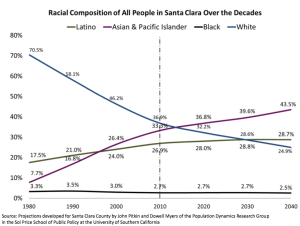
In the same 25 years, the share of non-Hispanic whites in Silicon Valley is expected to fall to less than 25 percent, down from 33 percent today and 70.5 percent in 1980. The share of Hispanics is predicted to remain largely unchanged at about a quarter of the valley’s total.
The findings, prepared for the city of San Jose Office of Economic Development, illustrate anew the valley’s unique demographics within the U.S. population. “It’s a completely different environment, no question,” said John Pitkin, a demographer and senior research associate at the USC Sol Price School. Pitkin helped with the Silicon Valley research.
Still, according to new U.S. Census Bureau projections, over the next 55 years, the popular kaleidoscope that has evolved in the valley and in other U.S. immigrant-gateway cities is expected to show itself across the nation too. “It is slower nationally and at lower levels,” Pitkin said, but the patterns are the same.
Silicon Valley has drawn the world’s citizens at a faster rate than the state and nation for years and has relied on the foreign-born for increases in its population. The foreign-born accounted for more than half of the 113,000-person rise in the valley’s population from April 2010 to July 2014, according to the latest Census Bureau estimates. Today, more than 37 percent of Silicon Valley residents were born outside the United States compared to 27 percent across California and 14 percent nationally. Silicon Valley will continue to see its foreign-born population rise in the next 25 years, plateauing at 40 percent of the total, according to Population Dynamics research.
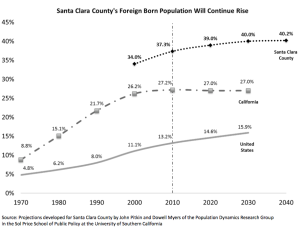
Meanwhile, nationally, by 2060, nearly one in five American residents are to be foreign-born, according to new Census Bureau estimates. Even as the population of non-Hispanic whites drops 8.2 percent to 182 million people, the Hispanic and Asian populations more than double to 119 million and 40 million respectively. Without new immigrants and their children over the next five-and-a-half decades, the U.S. population would fall by 5.8 million people rather than grow by 98 million, the Census Bureau says. Its estimates are based on historic trends and current public policy.
Historically, 15 U.S. metros, including San Jose-Sunnyvale-Santa Clara, San Francisco-Oakland-Fremont and Los Angeles-Long Beach-Santa Ana, have captured more than 60 percent of newly naturalized U.S. citizens and people gaining legal permanent residency, or their so-called “green card,” according to U.S. Department of Homeland Security data.
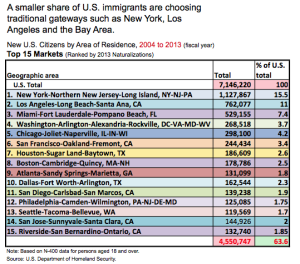
But as a group, the 15 are capturing a falling share as more immigrants disperse nationwide to places like Detroit, Phoenix, Minneapolis-St. Paul and Orlando-Kissimmee, Fla. Within the big 15, the shares are also shifting, with places such as Atlanta, Houston, Dallas, Miami and Washington, D.C., gaining “immigrant-share,” and New York, Los Angeles, San Jose and San Francisco all losing.
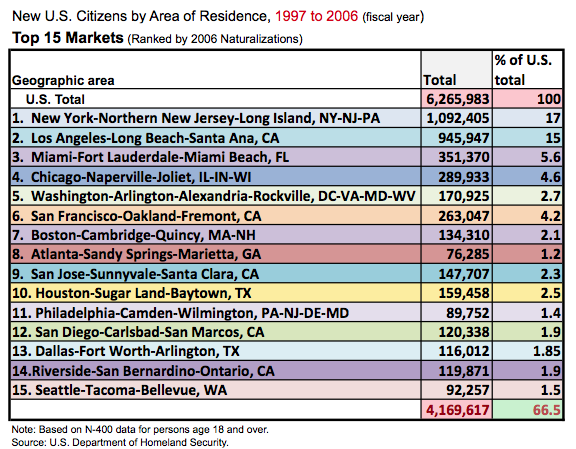
Going forward, U.S. immigrants are expected to continue to settle in a larger universe of U.S. cities and towns, Pitkin said. What is less understood are the effects on U.S. immigration from the now-global workforce. Today, people migrate as never before, trekking from one country to another then back home or to a third country, accumulating multiple citizenships. Can the U.S. in fact draw people from the world over and keep their talents as it has in the past? Right now, Pitkin said, “We have poor data. That is one of the really big unknowns in this picture.”
[…] Asians Now Outnumber Whites in Silicon Valley […]
[…] to a recent issue of Silicon Valley One World, more than 37 percent of Silicon Valley residents were born outside the United States, compared to […]
This really doesn’t come as a surprise since the demographics in the whole US are changing at a very fast rate. This is a trend that will continue to spread and we can just watch as the US becomes the most diverse country in the world.